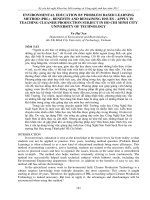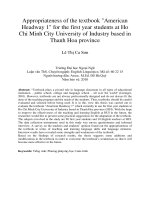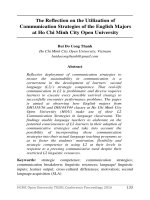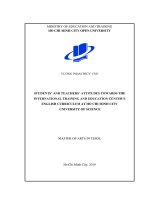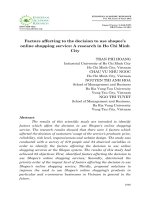The perception and use of vocabulary learning strategiesamong non english majors at ho chi minh city university of technology (hutech)
Bạn đang xem bản rút gọn của tài liệu. Xem và tải ngay bản đầy đủ của tài liệu tại đây (1.79 MB, 111 trang )
`
MINISTRY OF EDUCATION AND TRAINING
HO CHI MINH CITY UNIVERSITY OF TECHNOLOGY
----------------------
DOAN HUYEN TRAN
THE PERCEPTION AND USE
OF VOCABULARY LEARNING STRATEGIES
AMONG NON-ENGLISH MAJORS
AT HO CHI MINH CITY UNIVERSITY OF
TECHNOLOGY (HUTECH)
Major: English Language
Course code: 60220201
HO CHI MINH CITY, NOVEMBER, 2020
MINISTRY OF EDUCATION AND TRAINING
HO CHI MINH CITY UNIVERSITY OF TECHNOLOGY
-----------------------
THE PERCEPTION AND USE OF
VOCABULARY LEARNING STRATEGIES
AMONG NON-ENGLISH MAJORS
AT HO CHI MINH CITY UNIVERSITY OF
TECHNOLOGY (HUTECH)
Submitted to the
Faculty of English Language
in partial fulfillment of the Master’s degree in English Language
Course code: 60220201
By
DOAN HUYEN TRAN
Supervised by
NGUYEN THI KIEU THU, Ph.D.
HO CHI MINH CITY, NOVEMBER, 2020
HCMC UNIVERSITY OF TECHNOLOGY
POSTGRADUATE INSTITUTE
----------------------------------
HCMC, November 26th,2020
MASTER’S THESIS REPORT
Student’s name: Doan Huyen Tran
Sex: Female
Date of birth: May 05th, 1990
Place of birth: Tien Giang
Major: English Language
Student code: 1741900050
I- Thesis title:
The Perception and Use of Vocabulary Learning Strategies among Non-English Majors at
Ho Chi Minh University of Technology (HUTECH)
II- Objectives and contents:
The study aims to investigate vocabulary learning strategies of non-English majors at Ho
Chi Minh University of Technology (HUTECH). Three main objectives include probing
students’ perceptions in terms of their awareness and level of importance of vocabulary
learning strategies; students’ use in terms of frequency and preference; and the correlation
between students’ perception in terms of the level of the importance of vocabulary learning
strategies and their use in terms of frequency. Moreover, four groups of vocabulary
learning strategies are concentrated, comprising memory strategies (MEM), cognitive
strategies (COG), metacognitive strategies (MET), and social strategies (SOC).
The mixed methods approach was conducted in the current study. Questionnaires were
applied to collect quantitative data and processed by SPSS (24.0) to explore students’
perceptions; and students’ use. Besides, qualitative data was collected by structured
interviews to recognize students’ use. In the same vein with quantitative data, the
correlation between students’ perception and their use in terms of frequency was
determined by SPSS (24.0).
The findings showed that students were well-aware about vocabulary learning strategies of
the current study. Additionally, all those strategies were evaluated as important in learning
vocabulary. Regarding students’ use, four groups of vocabulary were used frequently.
Particularly, the majory of students considered social communication group as very
i
frequent use while memory group was not used as frequently as the three others.
Furthermore, “keep a vocabulary notebook with different topics” strategy” (COG), “watch
English movies” (MET), “ask teacher for an L1 translation” (SOC) and “say new word
alound when studying” (MEM) were used frequently. Students’ responses in terms of
preference also confirmed and supported students’ use in terms of frequency. Furthermore,
students’ perception correlated with students’ use in only cognitive group of vocabulary
learning strategies. There were not significant correlation between students’ perception and
students’ use in metacognitive group, social group, and memory group. It meant that
students could realized the level of importance of vocabulary learning strategies but they
did not use the strategies in metacognitive group, social group, and memory group as much
as they thought.
III- Starting date: October 18th, 2018
IV- Completing date: November 26th, 2020
V- Academic supervisor: Nguyen Thi Kieu Thu, Ph.D.
ACADEMIC SUPERVISOR
FACULTY DEAN
Dr. NGUYEN THI KIEU THU
Dr. NGUYEN THI KIEU THU
ii
CERTIFICATE OF ORIGINALITY
I certify my authorship of the Master’s Thesis submitted today entitled:
The Perception and Use of Vocabulary Learning Strategies among Non-English
Majors at Ho Chi Minh City University of Technology (HUTECH)
In terms of the statement of requirements for Theses in Master’s programs issued by the
Higher Degree Committee of the Faculty of English Language, Ho Chi Minh City
University of Technology.
Ho Chi Minh City, November, 2020
DOAN HUYEN TRAN
iii
RETENTION AND USE OF THE THESIS
I hereby state that I, DOAN HUYEN TRAN, being a candidate for the degree of Master of
Arts (in English Language) accept the requirements of the University relating to the
retention and use of Master’s Theses deposited in the Library.
In terms of these conditions, I agree that the original of my Master’s Thesis deposited in
the Library should be accessible for purposes of study and research, in accordance with the
normal conditions established by the Librarian for the care, loan, and reproduction for
theses.
Ho Chi Minh City, November, 2020
Signature
DOAN HUYEN TRAN
iv
ACKNOWLEDGEMENTS
I would like to express my deepest gratitude to my thesis supervisor, Dr. Nguyen Thi Kieu
Thu, who has provided insightful discussion, invaluable comments, straightforward
criticism and strong support in the preparation and completion of this thesis, asserting his
indispensable role as a whole-hearted thesis supervisor. Without her support and guidance,
this thesis would never have been completed.
My special thanks also go to the Institute of Postgraduate Studies, their staff members, and
all the instructors who taught and assisted me in the program.
I would also like to thank all those who were willing to give me their helpful hands in the
research project: the teachers in different faculties, in particular, Ms. Vo Thi Thu Huong,
Mr. Tran Trung Nghia, and Ms. Nguyen Thi Kim Ly for their great help and facilitation of
the data collection for the study, and their suggestive remedies; all the second-year nonEnglish majors participating in the research for their cooperation; and all my friends for
their support and encouragement in my fulfillment of the thesis. This thesis would hardly
have been made possible without the help, support, and incentive of a large number of
people who now deserve my heartfelt thanks.
I am also very grateful to Mr. Vo Duy Minh, for his kindness, priceless advice and
assistance in the process of doing the research.
Last but not least, my sincere thanks go to my family for their love, understanding and
support.
v
ABSTRACT
Vocabulary learning strategies are considered as “a wide spectrum of strategies used as
part of an on-going process of vocabulary learning” (Gu and Johnson, 1996, p. 669).
Furthermore, vocabulary learning strategies could support students to understand the
meaning of words and learn new words effectively. The aim of the study is to investigate
students’ perceptions and students’ use of vocabulary learning strategies among nonEnglish majors at Ho Chi Minh City University of Technology (HUTECH). In the context
of HUTECH, little is known about student’s perceptions and students’ use towards
vocabulary learning strategies researches. Therefore, there are three main issues addressed
in the study (1) to determine students’ perceptions in terms of awareness and the level of
importance of vocabulary learning strategies; (2) students’ use in terms of frequency and
preference; (3) the correlation between students’ perception in terms of the level of
importance of vocabulary learning strategies and their use in terms of frequency.
Particularly, mixed method is applied in this investigation. To accomplish the objectives
established in the research, questionnaires were used to collect quantitative data, which
was distributed to 350 sophomores from four different majors, namely Business
Administration, Marketing, Pharmacy, and Mechanical and Electronic Engineering.
Moreover, 10 sophomores were invited in structured interview to collect qualitative data.
The results showed that students were well-aware of vocabulary learning strategies of the
current study. Additionally, all those strategies were evaluated at important level in
learning vocabulary. Regarding students’ use, four groups of vocabulary were used
frequently. Particularly, a major of students used social strategies very frequently while
memory strategies were not used as frequently as three others. Students’ responses in terms
of preference also confirmed and supported students’ use in terms of frequency. On the
other hand, the correlations between students’ perception in terms of the level of
importance of vocabulary learning strategies and students’ use in terms of frequency were
both strong and weak. Students’ perception correlated with students’ use in only cognitive
group of vocabulary learning strategies. There were not significant correlation between
vi
students’ perception and students’ use in metacognitive group, social group, and memory
group.
Key words: vocabulary learning strategies, perceptions, use, mixed methods, non-English
majors.
vii
TABLE OF CONTENTS
Master’s thesis report…….…………………………………………….................. i
Certificate of originality…………………………………………………………... iii
Retention and use of the thesis……………………………………………………. iv
Acknowledgements……………………………………………………………….. v
Abstract…………………………………………………………………………… vi
Table of contents………………………………………………………………….. viii
List of tables………………………………………………………………………. xi
List of figures……………………………………………………………………... xiii
List of abbreviations………………………………………………………………. xiv
CHAPTER 1: INTRODUCTION
1.1 Background to the study.............................................................................. 1
1.2 Statement of the problem............................................................................. 1
1.3 Aims and objectives of the study................................................................. 3
1.4 Research questions....................................................................................... 3
1.5 Scope of the study………………................................................................ 4
1.6 Significance of the study………………...................................................... 4
1.7 Definitions of key terms.………………...................................................... 5
1.7.1 Vocabulary……………………...…………………………………. 5
1.7.2 Vocabulary learning strategies………………….…………………. 5
1.7.3 Perception……….…………...……………………………….……. 6
1.8 Organization of the thesis...……………..................................................... 6
CHAPTER 2: LITERATURE REVIEW
2.1 Vocabulary acquisition…………….…………………......…………….... 7
2.1.1 Vocabulary size for EFL…….…………….……......………...….... 7
2.1.2 Word knowledge…………………………………………………... 7
2.1.3 The importance of vocabulary……………………………………... 9
2.1.4 Factors affecting vocabulary acquisition…………………………. 9
viii
2.1.4.1 Intrinsic difficulties of the words…………………………… 9
2.1.4.2 The role of memory…………………………………………. 10
2.1.5 Teaching, learning and assessing vocabulary knowledge………...... 11
2.2 Vocabulary learning strategies……………………………………………. 12
2.2.1 The importance of vocabulary learning strategies………………...... 12
2.2.2 Vocabulary learning strategies……………..….………………….... 13
2.2.2.1 Incidental vocabulary learning……………………………… 13
2.2.2.2 Explicit vocabulary learning...……………………………… 13
2.2.2.3 Taxonomy of vocabulary learning strategies………………. 13
2.2.3 Schmitt’s vocabulary learning strategies………...……………….... 17
2.2.4 Training in the use of vocabulary learning strategies…………….... 19
2.3 Perception of vocabulary learning strategy……………………………… 20
2.4 Use of vocabulary learning strategy …………………………………...… 22
2.5 Previous studies..............................…….................................................... 22
2.6 Conceptual framework of the study…….................................................... 25
2.6 Chapter summary………………………………………………………… 27
CHAPTER 3: METHODOLOGY
3.1. Research design ......................................................................................... 29
3.2. Research site .............................................................................................. 31
3.3. Sample and sampling procedures .............................................................. 31
3.4. Research instruments ................................................................................. 33
3.4.1 Questionnaire…......………………………………………………... 33
3.4.2 Interview…......…………………………………………...………... 37
3.5. Statistic tools……………………………………………………..….…... 37
3.5.1 Descriptive statistics..………………………………………….…... 37
3.5.2 Reliability statistics………………………………………………... 38
3.6. Data collection procedures ......................................................................... 39
3.7. Data analysis procedures............................................................................. 41
3.7.1 Quantitative research….…………………………………………… 41
ix
3.7.2 Qualitative research………………………………………………… 42
3.8. Validity and reliability................................................................................ 43
3.8.1 Validity….................….…………………………………………… 43
3.8.2 Reliability…............….……….…………………………………… 44
3.9. Summary……………................................................................................ 44
CHAPTER 4: RESULTS AND DISCUSSIONS
4.1 Results…….................................................................................................. 45
4.1.1 Students’ perception of vocabulary learning strategies...................... 45
4.1.2 Students’ use of vocabulary learning strategies................................. 49
4.1.3 The correlation between students’ perception in terms of the level of the
importance of VLS and student’s use in terms of frequency …………… 58
4.2 Discussion…................................................................................................ 61
CHAPTER 5: CONCLUSION
5.1 Summary of the main findings of the study ................................................ 64
5.2 Pedagogical implications of the thesis ........................................................ 66
5.3 Limitations of the study............................................................................... 67
5.4 Recommendations for further research........................................................ 67
REFERENCES ......................................................................................................... 68
APPENDIXES .......................................................................................................... 78
Appendix A: Questionnaire……………………………………………………........ 78
Appendix B: Interview questions………………………………………………...… 91
Appendix C: Schmitt’s vocabulary learning strategies (1997)……………………... 93
Appendix D: Plagiarism check result ……………………………………………… 96
x
LIST OF TABLES
Table 2.1 What is involved in knowing a word……................................................. 8
Table 2.2 Intra-lexical elements that affect vocabulary learning………...………… 9
Table 2.3 Dimensions of vocabulary assessment…………………….……………. 12
Table 2.4 Taxonomies of vocabulary learning strategies…...……………………... 14
Table 3.1 The distribution for 350 students……...................................................… 32
Table 3.2 Rules of thumb for Cronbach’s Alpha.……………..…………………... 38
Table 3.3 Data collection schedule ………………………...……………………… 40
Table 3.4 Quantitative data collection schedule …………………………………... 40
Table 3.5 Qualitative data collection schedule …………………….…………........ 41
Table 4.1 The important levels of the strategies in cognitive group …………........ 46
Table 4.2 The important levels of the strategies in cognitive group …………........ 47
Table 4.3 The important levels of the strategies in metacognitive group …............. 48
Table 4.4 The important levels of the strategies in social group ……..………........ 48
Table 4.5 The important levels of the strategies in memory group ……………...... 49
Table 4.6 The frequent use of the strategies in cognitive group ………………..… 51
Table 4.7 The frequent use of the strategies in metacognitive group ……….……. 52
Table 4.8 The frequent use of the strategies in social group ……………………… 53
Table 4.9 The frequent use of the strategies in memory group ………...…………. 54
Table 4.10 Students’use of VLS in terms of preference …………………...………. 56
Table 4.11 The correlation between students’ perception and students’ use of
cognitive strategies………………………………………………………….……... 59
Table 4.12 The correlation between students’ perception and students’ use of
metacognitive strategies …………………………………………………………... 59
Table 4.13 The correlation between students’ perception and students’ use of
social strategies ……………………………………………………………………. 59
Table 4.14 The correlation between students’ perception and students’ use of
memory strategies …………………………………………………………...…...... 60
xi
Table 4.15 The most used strategies in four groups between Schmitt’s survey and this
investigation.......................………………………………………………………... 63
xii
LIST OF FIGURES
Figure 2.1 The process of perception.........………................................................... 19
Figure 2.2 Schmitt's Vocabulary learning strategies…………………….………… 21
Figure 2.3 The conceptual framework of the current study ………......................... 27
Figure 3.1 Flowchart of procedures in mixed methods design of the current study.. 30
Figure 4.1 The frequent use of cognitive strategies ………………………………. 50
Figure 4.2 The frequent use of metacognitive strategies…………………………... 51
Figure 4.3 The frequent use of social strategies……………………….…………... 52
Figure 4.4 The frequent use of memory strategies……………….………………... 54
xiii
LIST OF ABBREVIATIONS
HUTECH
Ho Chi Minh University of Technology
VLS
Vocabulary Learning Strategies
EF EPI
Education First English Proficiency Index
EFL
English as Foreign Language
COG
Cognitive Strategies
MET
Metacognitive Strategies
SOC
Social Strategies
MEM
Memory Strategies
xiv
CHAPTER 1
INTRODUCTION
This study aims at understanding non-English majors students’ perceptions towards
vocabulary learning strategies (VLS) and their strategies applied in learning vocabulary.
The research is conducted at Ho Chi Minh University of Technology (HUTECH). First,
the chapter starts with the background to the study in which the general information and
the rationale of the study are presented. Next, the research questions are designed to
discover the issues relevant to vocabulary learning strategies. Then, statement of the
problem, aims and objectives of the study, significance of the study, and scope of the study
are described in details. Last, the study proposes definitions of key terms and organization
of the study.
1.1 Background to the study
The influence of English language has been so widespread in different fields such as
education, economics, technology and daily life. Specifically, regarding the field of
education, there has been a great research investigating the importance of English language
in higher education and workplace settings (e.g., Do Huy Thinh, 2006) and English as an
indispensable subject in the entire education system from primary level to higher education
(e.g., Ton Nu Nhu Huong, Pham Hoa Hiep, and Vo Thi Hoang Nguyen, 2010). However,
according to the Education First English Proficiency Index (EF EPI) in 2019, Vietnamese
people’s proficiency in using English is ranked at 52nd out of 100 countries and religions
with a score of 51.57, which is considered low proficiency. In Asia, Vietnam ranked the
10th position out of 25 countries and regions. Therefore, enhencing the proficency in using
English is very essential for Vietnamese learners.
Besides the four language skills in English (listening, reading, writing, and speaking)
receiving proper attention from both teachers and students, there are three critical aspects
of English language learning: vocabulary, pronunciation, and grammar. Among them,
1
vocabulary is asserted to be “the core or heart of language” (Lewis, 1993, p. 89). Thus,
there has been a dramatic increase in the number of studies discussing various issues in
vocabulary learning and teaching (e.g., Carter & McCarthy, 1988; Nation, 1990; Arnau &
Bejoint, 1992; Hatch & Brown, 1995; Coady & Huckin, 1997; Schmitt, 1997, 2000).
Similarly, in the Vietnamese setting, vocabulary teaching and learning also attracts
considerable attention from the local language scholars (e.g., Tran Van Duong, 2008; Le
Nguyen Huong Giang, 2009; Le Thi Bao Tran, 2010; Nguyen Thi Anh Dao, 2012; Nguyen
Binh Nguyen, 2013) in teaching and learning of English as a Foreign Language (EFL).
According to Schmitt (1997), in order to learn vocabulary effectively, learners or students
must have specific vocabulary learning strategies. Therefore, Schmitt (1997) provides
discovery strategies and consolidation strategies into groups, including discoverydetermination,
discovery-social,
consolidation-social,
consolidation-memory,
consolidation-cognitive, consolidation-metacognitive.
1.2 Statement of the problem
One of the major problems encountered by students that teachers of English have been
concerned about for years is deficient vocabulary (Mumary, 2017). Due to their inadequate
word knowledge, students usually struggle to deal with performing the skills of English,
even when they are provided with progressive English language education. It cannot be
denied that vocabulary plays an important role in learning English; however, little is
known about student’s perceptions and students’ use towards vocabulary learning
strategies researches in the context of HUTECH. Hence, this study seeks to obtain
comprehensive data which would help to address the issues regarding vocabulary learning
strategies. Specifically, how non-English majored students perceive English vocabulary
learning strategies as well as types of strategies students employ in their English
vocabulary learning that would be recognized in the current investigation.
According to Dinh Tan Thuy Kha (2011), EFL students, undeniably, usually stick to
common practices: (1) concentrating on word lists provided by their teachers; yet, they are
normally unable to complete the list since they are not sufficiently motivated; (2) having
2
no successful strategies to learn vocabulary or lacking effective application of vocabulary
for outside classroom activities or even inside classroom situations. In fact, English
teachers’ evaluations and students’ achievement in English subject recently show that the
most salient issue is the lack of vocabulary of students. Therefore, an investigation on
vocabulary learning strategies is necessary to consolidate students’ vocabulary acquisition
as well as enhance students’ vocabulary size.
1.3 Aims and objectives of the study
The purpose of this study is to investigate vocabulary learning strategies (VLS) of nonEnglish majors at HUTECH. The objectives of the study are as follows:
(1) to examine HUTECH non-English major students’ perception towards vocabulary
learning strategies, which involves awareness and the level of importance of the strategies.
(2) to survey non-English major students’ use of vocabulary learning strategies in terms of
frequency and preference.
(3) to find the correlation between students’ perception and their use of vocabulary learning
strategies.
1.4 Research questions
In order to achieve the aforementioned aims, this study is guided by the following
questions:
(1) How do non-English major students in HUTECH perceive vocabulary learning
strategies in terms of awareness and the level of importance of the strategies?
(2) How do non-English major students in HUTECH use vocabulary learning strategies in
terms of frequency and preference?
(3) What is the correlation between students’ perception and their use of vocabulary
learning strategies?
1.5 Scope of the study
Firstly, due to practical constraints, this study does not provide a comprehensive review
3
of lexical issues. Hence, it mainly concentrates on students’ perceptions and students’ use
of vocabulary learning strategies, which are limited within four emergent groups, namely
memory strategies (MEM), cognitive strategies (COG), metacognitive strategies (MET),
and social strategies (SOC) because these four groups of strategies are the most frequent
surveyed in previous authors (Nation, 1990; Stoffer, 1995; Gu & Johnson, 1996; Kudo,
1999; Schmitt, 1997, 2000). Secondly, the target sample in this investigation is focused
on sophomores of non-English majors at Ho Chi Minh University of Technology
(HUTECH) and students of other levels are not involved in the study. Besides, the
effectiveness of the application of the vocabulary learning strategies are also beyond the
scope of the current study.
1.6 Significance of the study
Practically, the findings could make important contributions to raising students’ awareness
in vocabulary learning strategies. In other words, the findings of this study are expected to
extend students’ recognition for strategies applied in vocabulary learning. This in turn is
expected to motivate students in language learning in general and develop vocabulary
learning in particular.
Furthermore, with the data collected, the investigation is also beneficial for English
teachers in general and those who teach undergraduate students at HUTECH in particular.
It also provides an opportunity for teachers to review their strategies in vocabulary teaching
and determine their students’ strategies in vocabulary learning, from which teachers can
adapt their instruction or revise their syllabi in English language teaching. They could
employ effective approaches in helping students to improve their English language in
general and vocabulary learning in particular.
Theoretically, the findings may provide additional evidences with respect to language
researchers for references in relating to the perception and use of vocabulary learning
strategies.
4
1.7 Definitions of key terms
1.7.1 Vocabulary
Hatch and Brown (1995) who saw it as a list or a set of words for a particular language or
a list or set of words that individual speakers of language might use. In the current study,
it refers to definite and study English new words for non-English majors.
1.7.2 Vocabulary learning strategies
According to Smith (2000), vocabulary learning strategies can be defined as approaches of
facilitating vocabulary learning. They include cognitive strategies, metacognitive
strategies, memory strategies, and social communication strategies.
1.7.3 Perception
Perception in Latin is perceptio or percipio that means “receiving, collecting, action of
taking possession, and apprehension with the mind or senses” (Ou, 2017, p. 18). In the
current study, it refers to examine students’ awareness and the level of importance of the
strategies.
1.8 Organization of the thesis
This study is composed of five chapters as follows:
Chapter 1 introduces the background to the study, and states the problem under
investigation as students’ perception and students’ use of vocabulary learning strategies.
The aims and objectives of the study are followed by. It also includes the research
questions, the scope and significance of the study along with definitions of key terms and
it finalizes with the structure of the thesis.
Chapter 2 reviews the literature and previous studies related to vocabulary and
vocabulary learning strategies in terms of memory strategies, cognitive strategies,
metacognitive strategies, and social strategies. This chapter concentrates on the most
popular vocabulary learning strategies widely discussed in previous studies developed as
the conceptual framework for the study.
5
Chapter 3 presents the methodology, mixed-method approach with questionnaire
and individual interview, and research design for the study. This chapter involves the
sampling, data collection and analysis procedures.
Chapter 4 analyzes the data collected with SPSS to anwer the three research
questions. Discussions of the findings with follow the analysis of the data collected.
Chapter 5 presents a summary of the key findings in response to the research
questions as well as their implications for language education in general and learning of
English vocabulary in particular. The chapter also acknowledges some limitations of the
study and finalizes with recommendations for further research.
6
CHAPTER 2
LITERATURE REVIEW
The chapter begins with various aspects of vocabulary acquisition, including vocabulary
size for EFL, word knowledge, the importance of vocabulary and factors affecting
vocabulary acquisition. Next, a review of different groups of vocabulary learning strategies
is proposed in details. In this chapter, the most popular vocabulary learning strategies
discussed in previous studies are developed as the conceptual framework for the study.
2.1 Vocabulary acquisition
2.1.1 Vocabulary size for EFL
The number of words would influence his or her proficient language skills. Nation (1990)
argues that a learner should know approximately 2,000 to 3,000 words for using English
effectively. Furthermore, in order to read in advanced, authentic and academic contexts, a
learner is required to have at least 5,000 words (Hirsh & Nation, 1992). Similarly, Schmitt
(2000) also agrees that 5,000 words are a necessary limit to become a better English learner.
Consequently, learning and enhancing vocabulary effectively is a tremendous challenge
for English learners in general and non-English majors in particular. Understanding this
kind of students’ obstacle, many researchers (Oxford, 1990; Nation, 1990; Stoffer, 1995;
Gu & Johnson, 1996; Kudo, 1999; Schmitt, 1997, 2000) have been creating vocabulary
learning strategies to help students learn vocabulary more effectively in order to develop
the source of vocabulary needed for their language proficiency.
2.1.2 Word knowledge
Vocabulary has been discussed and distinguished in two types known as productive
knowledge and receptive knowledge (Hiebert & Kamil, 2005). Being able to connect a
word with listening and reading is known as receptive knowledge while using a word in
speaking and writing is seen as productive knowledge (Hatch & Brown, 1995; Schmitt,
2000; Stuart, 2008). Furthermore, as proposed by Nation (2001, p. 27), the following table
7
refers to the aspects involved to know a word.
Table 2.1 What is involved in knowing a word (Nation, 2001)
Aspect
Component
Spoken
Receptive knowledge
What does the word
How is the
pronounced?
sound like?
Written
Form
Meaning
Productive knowledge
What does the word
How is the word written
and spelled?
look like?
Word parts
What
parts
recognizable in
word?
Form and
What meaning does
meaning
this word form signal?
Concepts and
What is included in this What items can
concept?
concept refer to?
Referents
word
are What word parts are
this needed to express the
meaning?
What word form can be
used to express this
meaning?
the
Associations
What other words does What other words could
this make people think people use instead of this
of?
one?
Grammatical
Functions
In what patterns does the In what patterns must
word occur?
people use this word?
Collocations
What words or types
What words or types
of words occur with
this one?
of words must people use
with this one?
Constraints
Where, when, and
Where, when, and
on use
how often would
Use
(register,
frequency...)
how often can people use
people expect to meet this word?
this word?
Based on Nation’s description in Table 2.1, students should remember at least three aspects
of a word, comprising form, meaning and use. Regarding the form of a word, students are
8
required to know three components as spoken form (pronunciation), written form (spelling)
and word parts (prefix, suffix, root). For instance, the word parts of “incredible”, the prefix
is in- that means negative, cred is the root and -ible is suffix. The meaning of a word should
be learned with form-meaning link, concepts and referents, and associations. In addition,
form-meaning link is considered because many words are similar in form but different in
meaning. The use of a word is proposed as grammatical functions, collocations and
constraints.
2.1.3 The importance of vocabulary
Regarding the importance of lexis, Moeller, Ketsman and Masmaliyeva (2009) found that
“word knowledge is powerful as words serve as building blocks to learning” (p. 1). In
addition, Nation (2001) also stated that language use is enabled by knowledge of
vocabulary; conversely, vocabulary knowledge leads to an increase in language use.
Sharing similar perspectives, Laufer and Nation (1999), Maximo (2000), Read (2000), and
Gu (2003a) asserted that word knowledge is a very important component to complete oral
and written forms in different areas such as communication, literature, document (as cited
in Alqahtani, 2015). Moreover, Hirsch (2003) found that adequate reading comprehension
requires learners to know between 90 and 95 percent of the words in a text.
2.1.4 Factors affecting vocabulary acquisition
2.1.4.1 Intrinsic difficulties of the words
Schmitt (2000) states that students’ features including age, cultural background, and
motivation affect their vocabulary learning (p. 116). On the other hand, Laufer (1997)
described some other influential elements of lexical acquisition (p. 154) as follows:
Table 2.2 Intra-lexical elements that affect vocabulary learning
Facilitating factors
Familiar phonemes
Phonotactic regularity
Trouble-inducing
Factors with no influence
factors
Presence
of
foreign
phonemes
Phonotactic irregularity
9


